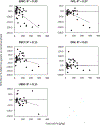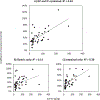Interconnected soil iron and arsenic speciation effects on arsenic bioaccessibility and bioavailability: a scoping review
- PMID: 34706629
- PMCID: PMC9850428
- DOI: 10.1080/10937404.2021.1996499
Interconnected soil iron and arsenic speciation effects on arsenic bioaccessibility and bioavailability: a scoping review
Abstract
Extensive research has examined arsenic (As) bioavailability in contaminated soils and is routinely assessed using in vitro bioaccessibility (IVBA) assays. Analysis of differences in bioaccessibility measurements across IVBA assays and phases is expected to provide valuable insights into geochemical mechanisms controlling soil As bioaccessibility and bioavailability. Soil iron (Fe) content and As speciation are expected to significantly influence IVBA gastric and intestinal phases due to fluctuations in precipitation-dissolution chemistry and sorption reactivity as pH and assay chemical complexity changes. The aim of this review was to examine these relationships by 1) conducting a meta-analysis (n = 47 soils) determining the influence of total Fe on As bioaccessibility measurements and 5 IVBA assays and 2) investigating the effect of As speciation on gastric/intestinal phase IVBA and in vitro-in vivo correlations. Our findings indicate that soil Fe content and As speciation heterogeneity are important in elucidating variability of bioaccessibility measurements across IVBA assays and gastrointestinal phases. Greater focus on coupled As speciation and Fe precipitation chemistry may (1) improve our understanding of soil geochemical factors and assay constituents that influence As in vitro-in vivo correlations and (2) resolve variability in the precision of oral relative bioavailability (RBA) estimated using IVBA assays for soils possessing heterogenous As speciation and Fe composition.
Keywords: Arsenic; bioaccessibility; bioavailability; coprecipitation; iron; meta-analysis; sorption; speciation.
Conflict of interest statement
Disclosure statement
No potential conflict of interest was reported by the authors.
Figures







References
-
- Akter KF, Owens G, Davey DE, and Naidu R. 2005. Arsenic speciation and toxicity in biological systems. Rev Environ Contam Toxicol 184:97–149. - PubMed
-
- Antelo J, Arce F, and Fiol S. 2015. Arsenate and phosphate adsorption on ferrihydrite nanoparticles. Synergetic interaction with calcium ions. Chem. Geol 410:53–62.
-
- Balint R, Celi L, Barberis E, Prati M, and Martin M. 2020. Organic phosphorus affects the retention of arsenite and arsenate by goethite. Journal of Environmental Quality 49 (6):1655–66. - PubMed
Publication types
MeSH terms
Substances
Grants and funding
LinkOut - more resources
Full Text Sources
Medical
Research Materials
